With two South East Asia (SEA) Games Marathon medals under his belt, as well as being the national record holder in the 10,000m track and the 15km and 20km road distances, marathoner Soh Rui Yong, 26, is well known in the Singapore running community.
So with the Standard Chartered Singapore Marathon (SCSM) coming up in less than seven weeks’ time, I caught up with one of Singapore’s fastest marathoners and picked his brain for tips on how to run marathons.
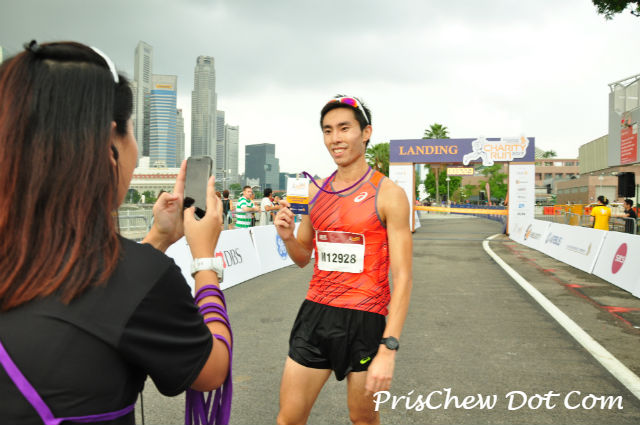
Soh Rui Yong has two SEA Games marathon medals under his belt.
Mileage should be peaking, with two months left to go
With eight weeks to go, Soh advises those taking part the 42.195km marathon, that they should be peaking in terms of their training mileage now.
He said, “During these next 5-6 weeks, you should really push it. That is the most crucial block of marathon training. Marathon training is largely about volume and the volume has to be there. It is also quite simple; just run a lot. Sometimes you run faster than race pace and other times you run at race pace and you will be good to go on marathon day.”
Continued Soh, “This period should be the bread and butter of your workouts. Do not be afraid to push the envelope during these weeks because after that, you will have 2-3 weeks to really recover, taper and get ready for the race itself.”
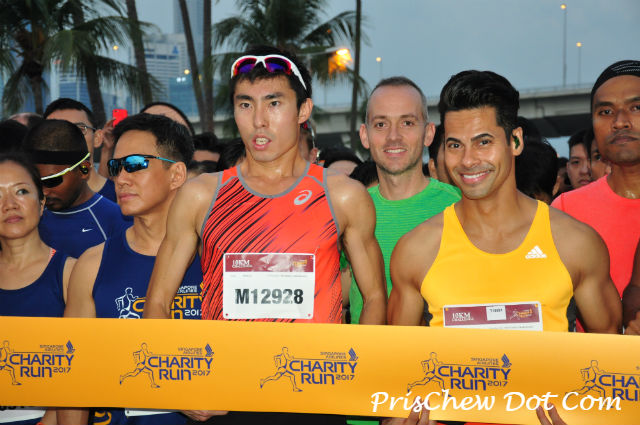
Marathon training is largely about volume, says Soh.
Have a good breakfast on race morning
On the morning of a marathon, Soh strongly recommends that runners should eat a good breakfast so that they will have fuel for the race.
Said Soh, “I think first and foremost, you need to have a good breakfast. For me it is two to four slices of peanut butter jelly toast with an isotonic drink. Eat when you are comfortable with but for me, it is an hour beforehand. The isotonic is important because you have to stay hydrated throughout the course of the race. You need to be well hydrated for the day before the race actually, and when you wake up, you have been fasting for so long because you have been asleep so it’s good to start hydrating right away. I have bread, H2O isotonic drink and a banana and I move off to the race and then start to warm up.”
Stick to what you know
Soh also urges runners to stick with what they know and not try anything new. He said, “I think some runners panic before the race and then start to do crazy things they don’t normally do. They would read up and come up with these crazy diets that they are not used to and run into problems as a result. You really have to stick to what worked for you in the training phase.”
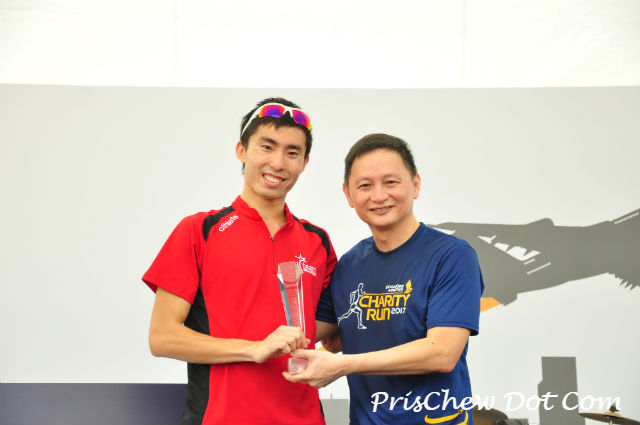
Soh advises runners to stick to what they know and do not try anything new.
Warm Up
When you get to the race site, Soh feels that warming up prior to the race is important to loosen the muscles and to get the blood flowing.
He explained, “Of course you have to warm up. I guess that the amount of time needed for warm up really depends on how well trained you are. For me, I only need 5-10 minutes to warm up. I take about 5 minutes to shuffle jog and then I do some light drills before going to the start line.”
Added Soh, “The first couple of kilometres can also be used for the warm up. For the SEA Games Marathon it was so hot that I did not need more than 5 minutes of shuffle jog and drills before I went to the start line.”
Do not start too fast
And once the horn blows to signal the start of the race, Soh pointed out that most runners start way too fast and crash and burn after that.
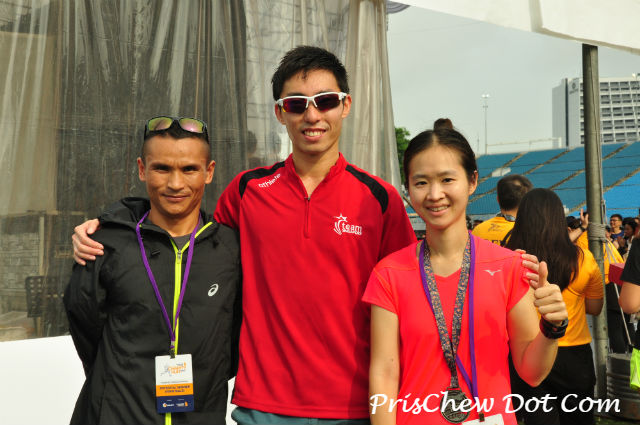
Many runners start too fast at races, says Soh.
He said, “Most runners start too fast. I would say that is 99% of runners in a marathon. It is easy to get carried away with the music, atmosphere and DJ and as a result, everyone is tackling a pace that they think they can sustain at the beginning because they feel good and well tapered and their bodies are fresh. But it is easy to go too fast at the beginning. You may feel like you can do anything at the start of the marathon, but you have got to stick to the race plan.”
He added, “If my race plan is 3:30mins/km then I stick to 3:30mins/km and do not run any faster. If it is 5:00mins/km then you stick to 5:00mins/km and nothing faster. It is ok to start slower though, like 10-20sec slower than your goal pace and warm up into it but if you start way faster, you will pay for it in the later stages of the marathon.”
Soh also pointed out that with the easy availability of GPS watches and phone tracking apps, it is not hard for runners to figure out if they are running too fast.
He added, “It is so easy to pace yourself now. Take one look at your GPS watch and if you are going way too fast, then you have got to slow down immediately. I think it is as simple as that. You have to ask yourself what you want to achieve in this run – that is, whether you just want to run a good first half or if you want to execute the whole race well.”
Take energy gels every 1/2 hour
As the marathon is a long race, Soh also added that taking in energy in the form of gels is important to last the distance.
He said “I recommend one gel every half an hour or so. For me it is one gel every 10km; that is about 35 minutes. If you are running a 5 hour marathon as opposed to a 2hour 30min marathon, maybe you can take gels more often. But on average I would recommend every 30 to 40 minutes is a good gauge at when to take a gel. I would also take a gel right before the race starts too, anyway.”
Hydrate Well
During the race, Soh also urges runners to hydrate themselves well, considering Singapore’s hot and humid climate.
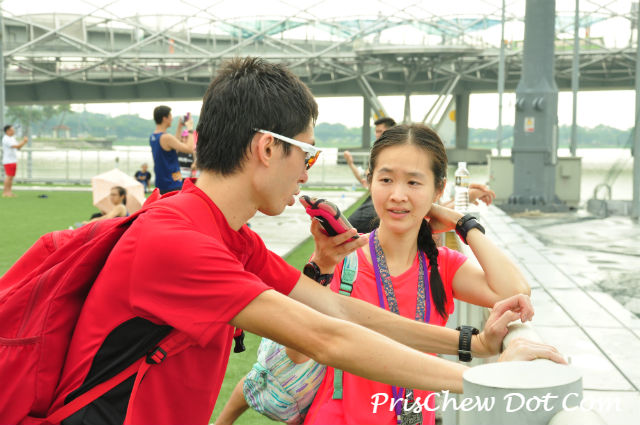
Interview with Soh in progress.
He said, “For marathons in tropical heat like SCSM, hydration becomes a lot more important and so does pacing. I think that I run well in the heat and humidity compared to other runners; that is why I won the SEA Games twice in really hot and humid conditions (Singapore in the 2015 Games and Kuala Lumpur, (KL) Malaysia in the 2017 Games). What I do is to hydrate a lot. I finished four litres of isotonic drink and water during the Sea Games KL Marathon; this is more than what I would drink in a cooler race.”
He added, “But there’s no need to stop to drink your hydration; just quickly grab a cup at every hydration station and keep on moving to save time.”
Why runners hit the wall
Runners hit the wall during marathons, according to Soh, because of two common reasons: they start too fast or because they do not fuel themselves properly during the race.
He said, “Basically you hit the wall when you run low in blood sugars and to keep the blood sugars up, you do not start too fast because that burns off all your carbs and do not change pace suddenly; I have seen even the best runners – they try to make a surge and it feels good for a while but by changing pace suddenly, it burns into your blood sugar and that is why people hit the wall too.”
Continued Soh, “From my experiences, I have only hit the wall once. That was at the London Marathon in 2016. I was injured for a month going in, and training was quite disruptive. I still went in trying to run my goal pace; maybe looking back, I should have run slower. I had run a 2:24hr marathon pace for 32km and then I really hit the wall and had to jog. I was struggling to make my way to the finish line, but that experience really taught me about the marathon, and so when I attempted my next marathon, that was at Chicago; I did a 2:24hr pace and finished that race strong. So for race day, you should run at a pace that is not about how fit you think you are, but how fit your training shows you are.”
This means that if a runner knows that he or she has not trained adequately for a marathon, then he or she should not try to run at a personal best (PB) pace at the beginning. Said Soh, “If you know your training is not enough, do not start at PB pace. Start slower and hopefully if your body feels good in the last 10km, then make up for the lost ground then. The main goal is to get to the finish line strong, and you cannot do that when you are hitting the wall, so be patient and take one kilometre one step at a time.”
He added, “A lot of the time though, runners can be impatient because the atmosphere at the start line is electrifying. There are tons of people, the music is blaring and the day that you have been waiting for is finally here; there is just too much excitement going on.”
Recovery after a marathon

According to Soh, runners should get carbs and proteins into their bodies after a marathon, to refuel.
And upon finishing a marathon, Soh recommends that runners immediately try and get in some carbs and proteins to speed up their rate of recovery. He said, “Get in some chocolate milk, a banana and isotonic drink. It really speeds up the rate of recovery because your body is getting back the carbs that it has lost during the run, as well as proteins to rebuild the damaged muscles.”
Going for a cool down jog also helps, added Soh. He explained, “This helps to get rid of the lactic acid and other waste products that have built up during the race, so you have to keep moving. That way you will recover faster, compared to if you just sit down immediately.”
For instance, taking last Sunday’s Singapore Airlines Charity Run as an example, Soh had explained that he had completed the 10km race as a tempo run, winning it in 32min 25sec, and then afterwards, he ran another 11km-12km as a cool down jog.

Leave a Comment